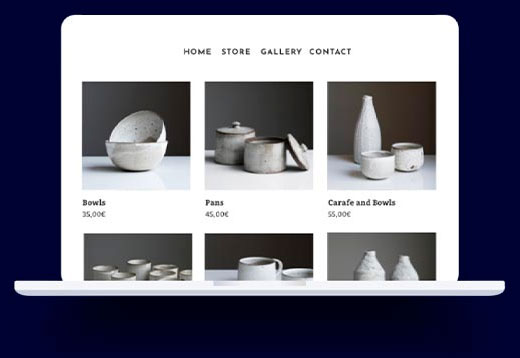Calculating prices for your product is one of the basic steps of opening your online store. Like many math problems, it can seem a lot more complicated than it actually is. In this article we’ll show you a simple method to calculate the selling price of a product in your online store.
You’ll find examples of how to calculate prices, see how discounts and shipping affect your prices, and you can use our selling price calculator to set the sales prices for your own store products.
Let’s dive in!
Start selling your products online with Jimdo.
A comfortable price point for customers
The right price has to be high enough for you to make enough profit, but low enough that customers are willing to pay it.
Many successful online stores work in a price range between 40 and 200 dollars. This sweet spot means every sale brings in enough margin to make it worth the cost of processing, packaging and shipping the order. It also means customers feel confident spending that amount.
How much are your customers willing to pay?
When you set your prices, have a look at what competitors are charging. Pay extra attention to competitors that have been in business for a long time. You may not know how they have calculated their prices, but you can be certain that a successful store uses pricing that customers are generally willing to pay.
Once your store is up and running, you can still experiment with different prices. If customers are willing to buy your product at 40 euros, will they also buy it at 45 euros?
The value of a good deal
Would you buy a pair of shoes for $2? Would you expect to get good quality? What about a pair of shoes for $200?
When customers compare different stores, they get a feel for the price range they can expect. If your store uses much higher prices, customers might expect a quality level they are not willing to pay for. The same goes for very low prices. If your prices are exceptionally low, raising your prices might actually help you sell more.
The ideal price point is where your customers think they get slightly more value than what they pay for.
Start selling your products online with Jimdo.
What does your price say about your brand?
Your prices set expectations. How you live up to those expectations influences how people see your brand. A good luxury brand makes people say: “It’s expensive, but it feels worth it.” For a good bargain hunter brand, that would be: “I can count on the lowest price.”
Think about how you want your pricing strategy to reflect your brand.
Basic calculation for your product prices
The basic selling price for your product is calculated with three numbers:
- cost price: how much you pay to make or supply the product
- profit margin: the percentage of profit you want to make
- taxes: the percentage of VAT or other tax you have to pay over the sale
First, apply the profit margin to the cost price. Then apply the taxes to that number.
Example:
A pair of shoes supplied has a cost price of $25.
You add a 20% profit margin.
The tax rate is 17%.
So your selling price before tax is:
$25 * 1.2 = $30
And your selling price including tax is:
$25 * 1.2 * 1.17 = $35.10
You can calculate selling prices for your own products with this calculator:
After calculating the selling prices for your products, you can set them in your online store.
What about shipping costs?
Shipping costs are generally charged separately. Once you have chosen a shipping option, you know the costs of shipping packages. Those costs may rise as the size and weight of the package increases. Smart product packaging can help you bring those costs down.
Some online stores make ordering attractive by offering free shipping. Obviously, the store still pays for the shipping. They manage this by spreading the expected shipping costs over all orders.
When to spread shipping costs:
- if you see that advertising with ‘free shipping’ brings in more orders
- if you can accurately estimate your total shipping costs
- if shipping costs are high compared to the price of your product
When to charge shipping costs:
- if you offer both shipping and local pick up in your store
- if your store is new and expected shipping costs are hard to predict
- if shipping costs are very low compared to the price of your product
You can set shipping costs in your store settings.
What about discounts?
Discounts are a great way to give customers the feeling of a good deal. For example, you can offer the customer the same value for a lower price if they order immediately. This urgency can convince doubters to buy, so they don’t miss the opportunity.
The discount is always applied to the price of the order. Shipping costs stay the same, even for discounted products.
You can set absolute discounts or percentage discounts. An absolute discount reduces the price of the order by a set amount. A percentage discount reduces the price by a set percentage.
This example shows how discounts work out on the final price for the customer:
Selling price: $35.10
Shipping costs: $5.00
Final price without discount:
$35.10 + $ 5.00 = $40.10
Final price with a $10.00 absolute discount:
($35.10 – $10.00) + $5.00 = $30.10
Final price with 10% percentage discount:
($35.10 * 0.9) + $5.00 = $36.59
Discounts are even more effective if customers can see what the product would normally cost. You can display that in your store by using strikethrough prices.
For more on discounts, read our guide on discount strategies for your online store.
Frequently asked questions about online store pricing.
Pricing is an important topic for online store owners. Here are some answers to common questions that will help you make decisions for your own online store.
Setting lower prices than your competitors can be a strategy to attract customers. However, prices make up a big part of how customers see your brand. Before you lower your prices, it’s good to experiment with discounts to see the effect on your sales.
Yes, it’s actually good practice to adjust your store prices from time to time. Your prices should change along with inflation and fluctuations in the market. Price experiments can also help you test if your price point is right for your target audience. Just don’t change your prices too often, so you don’t scare off returning customers.
Low prices can attract customers and help people discover your store. High prices can put you in the market as a high quality brand. The most important thing is that your price strategy should match your brand and your marketing strategy.
Showing prices that include tax is a standard in many countries. It’s also a great way to show customers you are transparent about your prices. Just make sure to indicate clearly to your customers that tax is already included.
It’s better to do your own price calculation. This ensures your prices are specific to the situation of your online store instead of your competitors. You can also use pricing to set your store apart from competitors by deliberately setting higher or lower prices.


